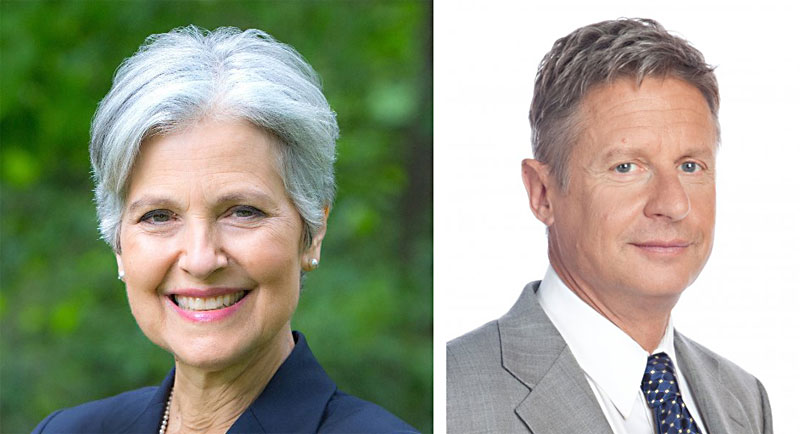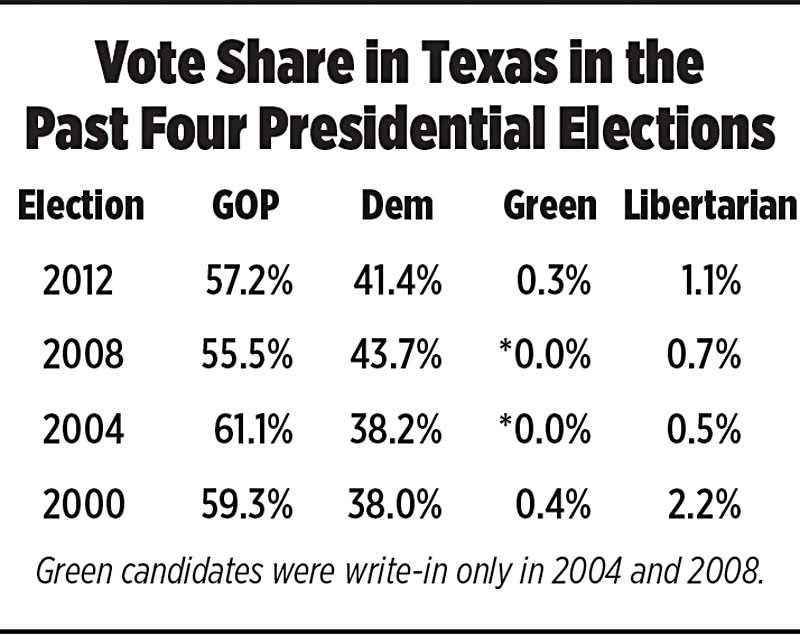Spoilers and Dreamers
Libertarian, Green parties scrap for votes
By Richard Whittaker, Fri., Sept. 16, 2016
America is a two-party state – in Republican Texas, that's arguably down to one. But that's not stopped the perennial third-party optimists from filing for office in the Nov. 8 election.
This year, four locals represent the Green Party on the ballot (two county seats, and two state reps; see "County Commissioner: A Question of Viability"), while the Travis County Libertarian Party has 11 candidates – four for state rep, two at the county level, four for Congress, and one for State Board of Education. TCLP chair and Congressional District 25 candidate Loren Schneiderman was candid that, while the Libertarians have historically fielded a big slate, there were often "a lot of placeholders. This time they're spending a little more time campaigning, with websites, Facebook, going to community events."
Travis County is arguably more favorable to third-party candidates than the rest of Texas. For example, in 2012 Libertarian presidential candidate Gary Johnson only took 1.11% of all votes cast in Texas in the presidential election, but in Travis County that more than doubled to 2.72%. Green presidential nominee Jill Stein over-performed similarly, taking 0.87% of Travis County votes compared to 0.31% statewide.
On the national stage, the headline battle is between Libertarians and Republicans. As that third party's nominee, former New Mexico Governor Johnson hopes to pull away disaffected Republicans who won't switch to the Democrats, but can't bring themselves to pull the lever for Donald Trump. His strategy seems to be working: The last Public Policy Polling numbers have Johnson at 6% in Texas – double what he polled when running in 2012.
The strangest crossover vote is arguably the Greens. Historically, the two parties were polar opposites, with Libertarians as the GOP's hard-line free market fringe, and Greens as the liberal and socialist option against Dems. Yet as rival protest magnets, Johnson appears to be eroding support for the increasingly marginalized Stein. For example, during the Sept. 1 ACC AFT endorsement meeting, Green Party activist Nicole Eversmann said she would vote for Johnson, and Adam Greeley, the Green party candidate for House District 46, recently posted a "Gary Johnson President 2016" button on his Facebook page.
Schneiderman called Johnson's nomination "a gold rush for us. Since the conventions, we've been getting more volunteers, we've been getting more people calling in and wanting to come to our meetings, we've been getting a lot more emails and donations." However, he admitted that it's not just because of Johnson. "We know that a lot of people are coming because of Trump, [but] Bernie supporters were quicker to go Libertarian than to go elsewhere." As for Stein, he said he was a little surprised, "because I've become a little more of a fan over the last few weeks."
Yet no matter how great the presidential downballot effect, the odds of either third party getting a local candidate elected seem extreme. Schneiderman pointed out both Kevin Ludlow (running against incumbent Democrat Dawnna Dukes in HD 46) and Rick Perkins (challenging Dem hopeful Gina Hinojosa to replace retiring HD 49 incumbent Elliott Naishtat) as serious candidates. Yet he also conceded that, even with the boost at the top of the ticket (especially if Johnson gets into the presidential debate) these are uphill battles. The greatest likelihood is for a third-party candidate to throw the balance in a two-horse race: For example, in 2006 Democrat Valinda Bolton could partially credit her HD 47 victory over Republican Bill Welch to Libertarian Yvonne Schick dragging away GOP votes. This time in that seat, longshot Democrat Ana Jordan might be looking at Libertarian Scott McKinlay to drag down incumbent GOPer Paul Workman the same way. So if the third parties remain seemingly unelectable, why run anyone?
The traditional argument for third-party candidates is to get their platforms in front of the public. Under former Travis County Libertarian Party Chair Pat Dixon, it was to overtly stick it to the Republicans (his argument was that there was no difference between the Dems and GOP, but at least the Democrats were honest about their policies). For Schneiderman, the endgame is ballot access. This year, all four parties will have their candidates listed on the Texas ballot because they all had candidates who polled at least 5% in at least one statewide race in 2014. If they can pull the same off again, then they'll be on the ballot in 2018.
Ballot access has a massive impact on voting patterns. In 2004 and 2008, the Greens were write-in candidates, and only pulled in 0.01%. In 2012, with actual ballot access, they had 31 times the vote share. True, that's still less than a third of a percent, but that could be the difference maker in a tight election.
For Schneiderman, that makes the Texas Railroad Commission the race to watch. Republican David Porter is standing down, and the race is seemingly between hard-line conservative and former state Rep. Wayne Christian, and perennial Democratic joke candidate Grady Yarbrough. As those two race to the bottom, it could be Libertarian Mark Miller, or the Green Party's Martina Salinas, upon whom their party's long-term hopes hang.
See more coverage of the Nov. 8 election at austinchronicle.com/elections.
Got something to say on the subject? Send a letter to the editor.












